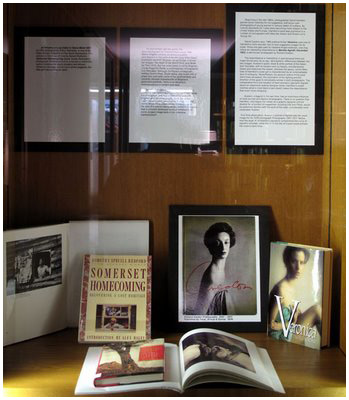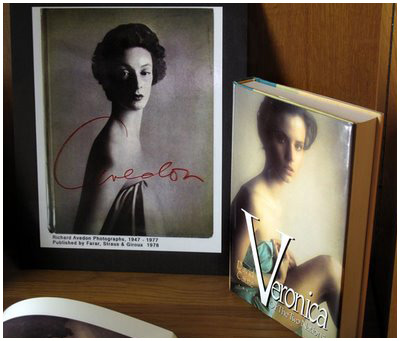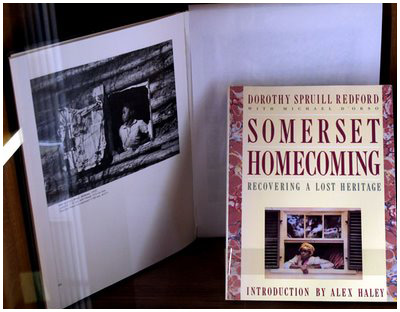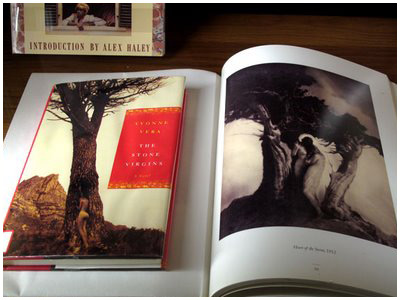
|
| Case 9 / 17 |
  |
Display Case 9 (Avedon, Brigman, Rothstein)
Beginning in the late 1960s, photographer David Hamilton gained some notoriety for his suggestive, soft-focus color photographs of young women in various states of undress. As cultural standards for nudity were becoming more relaxed in the United States and Europe, Hamilton's work was published in a number of monographs with titles like Sisters and Dreams of a Young Girl.
David Caute's racy, 1989 political thriller Veronica uses one of Hamilton's more discreet, but no less suggestive images for it's cover. Once one gets past its Vaseline-tinged eroticism, one may notice an interesting resemblance to Marella Agnelli, December 1953, a well-known photograph by Richard Avedon.
|
 |

Title: Veronica, or The Two Nations
Author: David Caute
Publisher: Arcade Publishing 1990
Designer / Illustrator: Robert Reed
Photographer: David Hamilton.
Title: Richard Avedon:Photographs 1947-1977
Publisher: Farrar, Straus & Giroux 1978
Designer: Elizabeth Paul Avedon .
|
The resemblance is 'interesting' in part because there are major formal and, let us say, 'atmospheric' differences between the two images. Avedon's spare, black & white portrait of the Italian-born Socialite, with its hauteur and icy beauty, simultaneously draws and distances the viewer, whereas the gauzy, come-hither look of Hamilton's cover girl is characterized by an unremarkable lack of ambiguity. Nevertheless, the general outline of the pose (bent knee excepted), the orientation of the lighting and the direction of the gaze is remarkably similar in both photographs. The comparative form and location of each woman’s 'garment' (Agnelli wears an expensive looking designer dress; Hamilton's model clutches what is most likely a bedsheet) makes the resemblance that much more intriguing.
Avedon, a legend in his own time, had an enormous influence on both portrait and fashion photography. There is no question that Hamilton, who began his career as a graphic designer and art director for a number of magazines, including Elle and Photo, would be extremely familiar with the work of the older, considerably more celebrated Avedon.
One final observation: Avedon's portrait of Agnelli was the cover image for his 1978 monograph Photographs 1947-1977. Notice how the large ‘A’ of Avedon's signature compliments the curve of Agnelli's shoulder, while the ‘V’ in the title of Caute's book echoes the model's bent knee.
|
At Window of Log Cabin in Gee's Bend 1937, by FSA photographer Arthur Rothstein, is one of the better-known images from the Great Depression. The picture on the cover of Dorothy Spruill Redford's Somerset Homecoming clearly recalls Rothstein's photograph. Redford's book is a memoir in which the author reclaims her slave ancestry and African-American heritage. As the cover photo suggests, the girl has become an adult.
Title: Somerset Homecoming
Author: Dorothy Spruill Redford
Publisher: Doubleday 1988
Designer / Illustrator: Not listed.
|
 |

Title: The Stone Virgins
Author: Yvonne Vern
Publisher: Farrar, Straus and Giroux 2003
Designer / Illustrator: Lynn Buckley
Photographer: Paige Deponte.
|
To one familiar with the genre, the cover photograph for Yvonne Vera's novel, The Stone Virgins, exhibits an almost uncanny resemblance to the work of the the early West Coast pictorialist Anne W. Brigman, (in particular, it recalls her images The Heart of the Storm 1912, and Nude by Tree 1915). But the cover photo is not by Brigman, it is by Paige De Ponte, a contemporary photographer and filmmaker. Although De Ponte's photograph, entitled Devil's Peak, South Africa, was made with a sharp lens and lacks some of the sentimentality and romantic sfumato characteristic of Brigman's pictorialist aesthetic, there is no denying a correspondence in content and style.
What makes Devil's Peak intriguing within the context of this exhibition is that when De Ponte made the photograph, she was entirely unfamiliar with Brigman and her photographic work. So, is the resemblance merely coincidental, a product of the 'Great Minds Think Alike' school of thought, or is the idea of a woman taking shelter beneath a gnarled tree in a barren landscape a visual template from some Jungian image bank in our collective subconscious?.
|
|
Write your comments:
|
|
